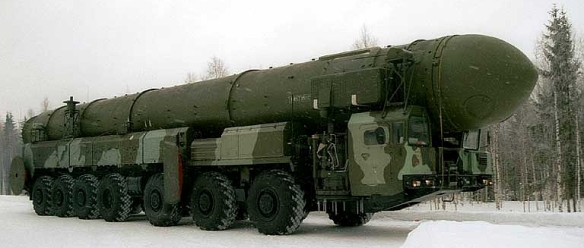
The RT-2PM Topol.
In 1977 MITT began development of the first Soviet road mobile ICBM to enter significant operational service, the RT-2PM. Due to the prior conflict over the Temp-2S and the fact that the SALT II treaty only authorized the development of a single new ICBM type, this was the RT-23, which is described later, the missile was given a designation which seemed to indicate that it was a follow-on design based on the Korolev RT-2. Developing modified variants of existing missiles was permitted under arms control agreements provided that they did not exceed a certain throw weight. In actuality, the RT-2PM was a follow on to the Temp-2S design. Flight testing at Plesetsk began in 1983, with the first operational missiles becoming available in 1985. On at least one occasion a variant with 4 MIRVs was tested, but this configuration was not deployed due to arms control reasons limiting the number of MIRV’ed ICBMs.
MOBILE ICBMS
To increase the survivability of land-based intercontinental ballistic missiles (ICBMs), military planners have always turned to mobility in order to complicate the calculations of an attacker. For the Soviet Union, development of mobile ICBMs was slow until the late 1960s owing to concerns about command and control and the ability to maintain positive control of Soviet missiles under all circumstances. Lack of communications links were an additional Soviet concern. In the United States, high operating costs and the need to operate systems over enormous expanses of land limited interest in mobile missiles. The U. S. Air Force pursued the railmobile Minuteman option in 1960, which would have been deployed at Hill Air Force Base, Utah, but for budgetary reasons Secretary of Defense Robert McNamara canceled the planned procurement of additional Minuteman ICBMs, which eliminated the need for the deployment scheme. As the accuracy of ICBMs improved, creating concerns about the survivability of ICBMs deployed in fixed silos, both superpowers revisited the issue of deploying mobile ICBMs.
The Soviets first attempted to use a tank chassis as a transporter for the SS-15 in 1968. After discovering that vibration of the chassis caused missile component failures, they canceled the system after ten test flights. After reviewing its options, the Soviet Strategic Forces decided that a truck chassis was a better vehicle than a tank chassis as a missile transporter, offered better road speeds, was relatively easy to maintain, and created fewer vibration problems. The SS-16 system that emerged in 1972 was concealable, highly mobile, and successful. It also became one of the major stumbling blocks in superpower arms control talks. The United States could not detect the missile launchers using reconnaissance satellites and tried to have mobile missiles banned. The SS-16 was specifically banned in the treaty resulting from the Strategic Arms Limitation Talks (SALT I), although the Soviets kept the missile in their inventory in violation of the treaty. It was eventually withdrawn from service when better systems were ready for deployment.
After the SS-16 was decommissioned, the designs were used in the highly successful SS-20 intermediate- range ballistic missile (IRBM) that entered the Soviet arsenal in the 1970s. Soviet planners also decided that they required a secure second-strike capability and eventually deployed the road-mobile SS-25 and the rail-mobile SS-24 ICBMs. The SS-25 carried a single warhead, while the SS-24 carried ten multiple independently targetable reentry vehicles (MIRVs). The SS-24 was deployed on missile trains that carried three missiles, their launchers, support equipment, and security railcars. These missile trains usually patrolled for about five days out of garrisons that were situated along the Trans-Siberian Railroad. In order to keep its defense posture as other strategic arms treaties entered into force, Russia replaced the SS-25 with the SS-27, another roadmobile missile.
TRANSPORTER-ERECTOR-LAUNCHER
A transporter-erector-launcher (TEL) is a self-propelled vehicle that transports and erects a missile to the vertical position in order to launch it. In the 1950s and 1960s, intercontinental ballistic missiles (ICBMs) were too heavy and too susceptible to vibration damage while being moved on a transporter. Development of a mobile ICBM was thus a high priority for both the United States and the U. S. S. R. The Soviet Union had a string of failures with its SS-14 intermediate-range ballistic missile (IRBM) and its SS-15 ICBM, which were mounted on a tracked tank chassis. These two systems were never widely deployed because the tracked TELs could barely carry the weight of the massive ICBMs. Only with the development of the SS-16 ICBM and the SS-20 IRBM did the Soviets achieve their goal of a wheeled TEL.
The TEL carries not only a missile that is environmentally protected, but also electronics to monitor the missile, alignment equipment, and communications links to receive orders from headquarters. To increase the pre-launch survivability of the missile, the TEL must be able to traverse a variety of terrain types and move quickly over a large distance, especially to disperse to operating areas when placed on alert or during a crisis.
Russia currently uses a slightly larger TEL for its SS-25 and SS-27 ICBM force. Other nations have developed but not deployed mobile ICBM TELs. The United States developed a complex vehicle for the single-warhead Midgetman ICBM that could withstand a nuclear blast by hugging the ground. The MX missile also could have been TEL mounted, but it was never deployed in this configuration. Other short-range missile systems, most notably the Scud missile, often are mounted on trucks or simple tracked vehicles.
Reference Podvig, Pavel, ed., Russian Strategic Nuclear Forces (Cambridge, MA: MIT Press, 2001). A History of Strategic Arms Competition, 1945-1972, vol. 3, A Handbook of Selected Soviet Weapon and Space Systems (Washington, DC: United States Air Force, June 1976), pp. 204, 205, 209, 216. Jane’s Weapon Systems 1987-88 (London: Jane’s Publishing Company, 1988).